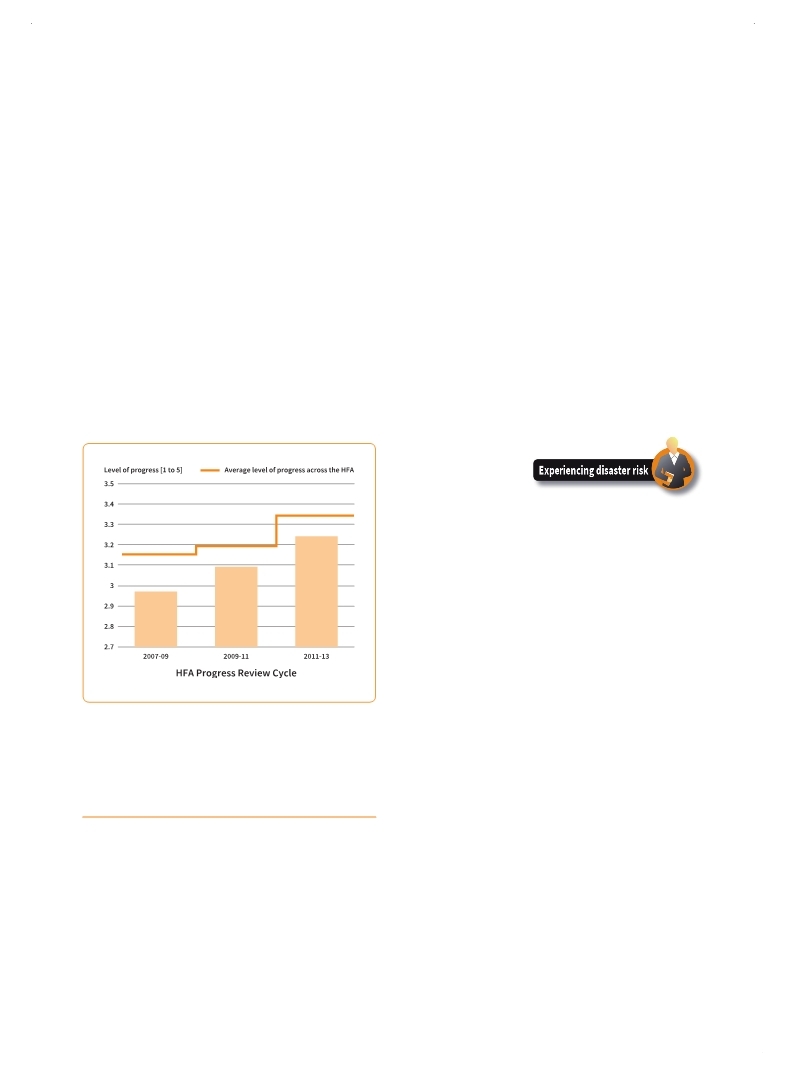 |
Global Assessment Report on Disaster Risk Reduction 2015
Making development sustainable: The future of disaster risk management |
 |
Global Assessment Report on Disaster Risk Reduction 2015
Making development sustainable: The future of disaster risk management |
|
|

134
Part II - Chapter 7
7.3 Experiencing disaster risk
Gaining risk awareness is a dynamic process which is highly dependent on disaster experience. It therefore differs across time and space.
Risk awareness and understanding would seem to be fundamentally experiential. For example, Japan has the highest level of hazard exposure in the world and has been dealing with repeated
disasters for millennia. Shaped by that experience, risk awareness is high amongst citizens and government authorities alike, research into risk identification and estimation is a priority, and risk knowledge permeates disaster risk management strategies and policies at all levels. Sustainability depends on sound disaster risk management.
In contrast, the disaster risk awareness of households, businesses and governments in countries with low levels of hazard exposure and infrequent disasters is likely to lack that essential experiential quality. Irrespective of public information on hazards, a strong political and economic imperative for disaster risk management is far less likely to emerge in those countries (Neumayer et al., 2012
Neumayer, Eric., Thomas Plümper and Fabian Barthel. 2012,The Political Economy of Natural Disaster Damage, February 2012.. . At the global level, disaster risk awareness is not systematically assessed, and it is difficult to measure how it has evolved since the adoption of the HFA or the declaration of the IDNDR. However, the number of nationally and internationally reported disasters has shown a strong upward trend since 1990 (Figure 7.2), which could indicate that more people have experienced manifestations of risk first-hand.
Large intensive disasters with major social and economic impacts certainly generate risk awareness, at least in the short term, and may catalyse change. As noted in Chapter 1, the impetus to reform risk governance arrangements often surfaces in the wake of large disasters. This change is not limited to governments. For example, the impact of the 2011 disasters in Japan and Thailand on global supply chains (UNISDR, 2013a
UNISDR. 2013a,Global Assessment Report on Disaster Risk Reduction: From Shared Risk to Shared Value: the Business Case for Disaster Risk Reduction, Geneva, Switzerland: UNISDR.. . This awareness (Box 7.2) continues to grow, and disaster and climate-related risks now figure
(Source: UNISDR with data from the HFA Monitor.)
Figure 7.1 Progress in risk awareness
HFA progress reports show that countries have made significant progress in this area. However, progress in general is lower than the average across the various priorities for action (Figure 7.1). With notable exceptions, citizens, businesses and other stakeholders in most countries rarely have access to risk information before they make investment decisions or undertake property transactions. As discussed below, there has been explosive growth in the production of risk information and in collaboration between scientific and technical institutions, but too little of this information ends up in the hands of users in a format that can inform decisions (CDKN, 2014
CDKN (Climate and Development Knowledge Network). 2014,Risk-informed decision-making: An agenda for improving risk assessments under HFA2, CDKN Guide, April 2014.. . |
 
Page 1Page 10Page 20Page 30Page 40Page 50Page 60Page 70Page 80Page 90Page 100Page 110Page 120Page 124Page 125Page 126Page 127Page 128Page 129Page 130Page 131Page 132Page 133Page 134Page 135->Page 136Page 137Page 138Page 139Page 140Page 141Page 142Page 143Page 144Page 145Page 146Page 147Page 148Page 150Page 160Page 170Page 180Page 190Page 200Page 210Page 220Page 230Page 240Page 250Page 260Page 270Page 280Page 290Page 300Page 310
|
|
 
|
 
|
